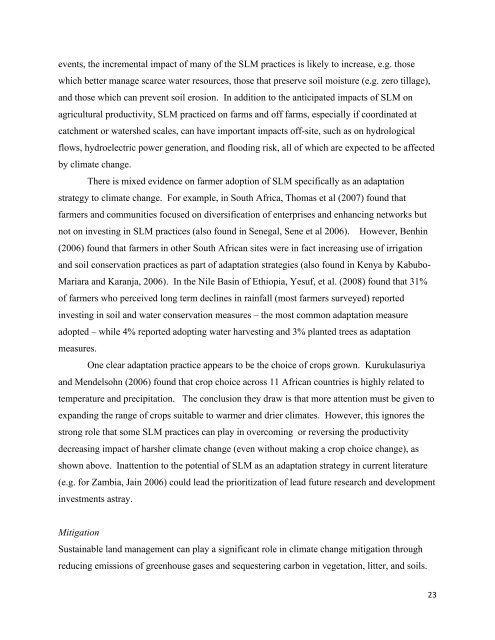The Role of Sustainable Land Management for Climate ... - CAADP
The Role of Sustainable Land Management for Climate ... - CAADP
The Role of Sustainable Land Management for Climate ... - CAADP
Create successful ePaper yourself
Turn your PDF publications into a flip-book with our unique Google optimized e-Paper software.
!<br />
events, the incremental impact <strong>of</strong> many <strong>of</strong> the SLM practices is likely to increase, e.g. those<br />
which better manage scarce water resources, those that preserve soil moisture (e.g. zero tillage),<br />
and those which can prevent soil erosion. In addition to the anticipated impacts <strong>of</strong> SLM on<br />
agricultural productivity, SLM practiced on farms and <strong>of</strong>f farms, especially if coordinated at<br />
catchment or watershed scales, can have important impacts <strong>of</strong>f-site, such as on hydrological<br />
flows, hydroelectric power generation, and flooding risk, all <strong>of</strong> which are expected to be affected<br />
by climate change.<br />
<strong>The</strong>re is mixed evidence on farmer adoption <strong>of</strong> SLM specifically as an adaptation<br />
strategy to climate change. For example, in South Africa, Thomas et al (2007) found that<br />
farmers and communities focused on diversification <strong>of</strong> enterprises and enhancing networks but<br />
not on investing in SLM practices (also found in Senegal, Sene et al 2006). However, Benhin<br />
(2006) found that farmers in other South African sites were in fact increasing use <strong>of</strong> irrigation<br />
and soil conservation practices as part <strong>of</strong> adaptation strategies (also found in Kenya by Kabubo-<br />
Mariara and Karanja, 2006). In the Nile Basin <strong>of</strong> Ethiopia, Yesuf, et al. (2008) found that 31%<br />
<strong>of</strong> farmers who perceived long term declines in rainfall (most farmers surveyed) reported<br />
investing in soil and water conservation measures – the most common adaptation measure<br />
adopted – while 4% reported adopting water harvesting and 3% planted trees as adaptation<br />
measures.<br />
One clear adaptation practice appears to be the choice <strong>of</strong> crops grown. Kurukulasuriya<br />
and Mendelsohn (2006) found that crop choice across 11 African countries is highly related to<br />
temperature and precipitation. <strong>The</strong> conclusion they draw is that more attention must be given to<br />
expanding the range <strong>of</strong> crops suitable to warmer and drier climates. However, this ignores the<br />
strong role that some SLM practices can play in overcoming or reversing the productivity<br />
decreasing impact <strong>of</strong> harsher climate change (even without making a crop choice change), as<br />
shown above. Inattention to the potential <strong>of</strong> SLM as an adaptation strategy in current literature<br />
(e.g. <strong>for</strong> Zambia, Jain 2006) could lead the prioritization <strong>of</strong> lead future research and development<br />
investments astray.<br />
Mitigation<br />
<strong>Sustainable</strong> land management can play a significant role in climate change mitigation through<br />
reducing emissions <strong>of</strong> greenhouse gases and sequestering carbon in vegetation, litter, and soils.<br />
!<br />
%&!

















